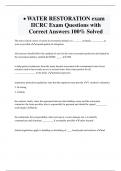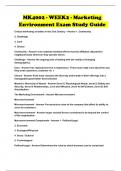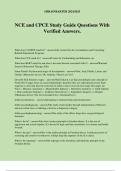Chapter 1 Introduction to Psychological Assessment
Why we do it and what it is
The language of assessment
Types of tests
Psychological testing and assessment are important in virtually every aspect of professional
psychology. The last 60 years have seen an explosion in terms of test development and use
of psychological and educational tests. A test is a device or procedure in which a sample of
an individual’s behavior is obtained, evaluated, and scored using standardized procedures.
Cronbach (1990) noted that tests generally can be classified as measures of either
maximum performance or typical response. Maximum performance tests also are referred to
as ability tests, but achievement tests are included here as well. They are designed to
assess the upper limits of the examinee’s knowledge and abilities. In contrast, typical
response tests attempt to measure the typical behavior and characteristics of examinees.
Often, typical response tests are referred to as personality tests, and in this context
personality is used broadly to reflect a host of noncognitive characteristics such as attitudes,
behaviors, emotions, and interests.
Within the broad category of maximum performance tests, there are a number of
subcategories. First, maximum performance tests are often classified as either achievement
or aptitude tests. Achievement tests are designed to assess the knowledge or skills of an
individual in a content domain in which he or she has received instruction. In contrast,
aptitude tests are broader in scope and are designed to measure the cognitive skills,
abilities, and knowledge that an individual has accumulated as the result of overall life
experiences. Second, they can be classified as either objective or subjective. Objectivity
typically implies impartiality or the absence of personal bias. In contrast, subjective tests are
those that rely on the personal judgement of the individual grading the test. Finally,
maximum performance tests are often described as either speed or power tests. On a pure
speed test, performance only reflects differences in the speed of performance. It generally
contains items that are relatively easy and has a strict time limit that prevents any examinees
from successfully completing all the items. One a pure power test, everyone is given plenty
of time to attempt all the items, but the items are ordered according to difficulty, and the test
contains some items that are so difficult that no examinee is expected to answer them all.
Well-developed speed and power tests are designed so no one will obtain a perfect score,
because perfect scores are ‘indeterminate’.
When describing personality tests, most assessment experts distinguish between objective
and projective techniques. Objective personality tests are those that use selected-response
items and are scored in an objective manner. Projective personality tests typically involve the
presentation of unstructured or ambiguous materials that can elicit an almost infinite range of
responses from the examinee. What is unique to projective tests is what is referred to as the
‘’projective hypothesis’’, which holds that when an examinee responds to an ambiguous
stimulus, he or she responds in a manner that reflects the person’s genuine unconscious
desires, motives, and drives without interference from the ego or conscious mind. The
controversy of projective techniques focuses on the subjective nature of this approach and
the lack of empirical evidence supporting the technical qualities of the instruments.
Types of scores
Almost all tests produce scores that reflect or represent the performance of the individuals
taking the tests. There are two fundamental approaches to understanding scores: the norm-
referenced approach and the criterion-referenced approach. With norm-referenced score
,Mastering Modern Psychological Testing
interpretations an examinee’s performance is compared to the performance of other people.
With criterion-referenced score interpretations, the examinee’s performance is not compared
to that of other people; instead it is compared to a specified level of performance. The
emphasis is on what examinees know or what they can actually do, not their standing
relative to other people. Thus, norm-referenced interpretations are relative whereas criterion-
referenced interpretations are absolute.
Common applications of psychological assessments
Tests and other assessments have many uses, but underlying practically all of these uses is
the belief that they provide information about important psychological constructs, and that
this information can help psychologists and other professionals make better decisions.
Prominent applications of assessment procedures will now be briefly described.
Diagnosis is implied when a health care professional specifies the nature and/or cause of a
disorder, disease, or injury. In psychology and psychiatry, the diagnostic process typically
incorporates information obtained using a variety of assessment procedures and utilizes the
DSM as the guiding taxonomy. Ideally, diagnosis involves more than simply specifying a
diagnostic category, but explains the nature of the problem the client is experiencing and
guides the development of a treatment plan. As a result, diagnosis is an integral part of
effective treatment. Psychological assessment can also provide important information that
helps psychologists and other professionals tailor their interventions to meet the specific
needs of the individual client. Furthermore, psychological and educational assessments can
provide information that promotes self-understanding and helps individuals plan for their
future. Educators can also use a variety of assessment procedures to monitor the academic
progress of their students. In addition to providing information about individuals, assessment
can also provide information about the quality and usefulness of programs.
,Mastering Modern Psychological Testing
Chapter 11 Behavioral assessment
Behavioral assessment has a storied history in psychology and has evolved from a simple
counting of behavioral occurrences to more sophisticated rating scales and observational
schemes. Although professional psychologists traditionally have focused primarily on
assessment of cognitive abilities and personality characteristics, the drive for less inferential
measures has led to a renewal of interest and use of behavioral assessment methods.
Behavioral assessment as most commonly conducted is a measure of typical responding as
are personality scales. However, behavioral assessment differs from traditional personality
assessment in several ways. Behavioral assessment emphasizes what a person does and in
this context emphasizes observable behavior as opposed to covert thoughts and feelings. It
attempts then to define how a person behaves overtly on a day-to-day basis using
observable expression and acts as the primary means of evaluating behavior. Most methods
of personality assessment, however, emphasize what a person has, for example his or her
character or thoughts. Behavioral assessment is generally seen as more objective than
personality assessment because most behavioral assessment scales do not ask for
interpretations of behavior, only observations of the presence and frequency of a specified
behavior. However, the lines between behavioral assessment and some forms of traditional
personality assessment do blur at points. They are also quite complementary - it is important
to know both how people typically behave and how they think and feel. It is common practice
now for clinicians to use a multimethod, multimodal approach to behavioral assessment.
Practitioners will collect data or assessment information via behavioral interviewing, direct
observation, and impressionistic behavior rating scales, as well as self-report ‘’personality
scales’’, designed to reduce the level of inference involved in their interpretation.
Assessing behavior
Whereas we might not consciously be aware of it, we all engage in the assessment and
interpretation of behavior on a regular basis. We use informal evaluations to determine with
whom we want to associate and who we want to avoid, among many other ways. Clinicians
use behavioral assessment to produce far more objective determinations about the behavior
of individuals. By using standardized behavioral assessment methods such as behavior
rating scales, practitioners can also determine the degree to which behaviors cluster
together to reflect broader behavioral dimensions. In addition to telling us if clients behave in
particular ways, behavior rating scales also indicate how common or rare these behaviors
are in the general population.
Most assessments begin with a review of the referral information and statement of the
referral questions. Next comes a form interview with the person to be evaluated, or in the
case of a child or adolescent, an interview with a parent or caregiver may occur first. The
clinician brings out the presenting problem in this way and then solicits a detailed history and
attempts to understand the current mood states of the interviewee as well as any relevant
traits of interest and seeks to understand the psychodynamics of the behaviors or states of
concern. Behavioral interviewing has a different emphasis.
When conducting a behavioral interview, once the issue to be addressed has been
established, the clinician focuses on the antecedents and consequences of behaviors of
concern as well as what attempts at change have been made. Problem-solving strategies
are then introduced that are intended to lead to an intervention. The six steps in behavioral
interviewing can be summarized as follows:
1. Identify the presenting problem and define it in behavioral terms.
2. Identify and evaluate environmental contingencies supporting the behaviors.
, Mastering Modern Psychological Testing
3. Develop a plan to alter these contingencies and reinforcers to modify the behavior.
4. Implement the plan.
5. Evaluate the outcomes of treatment or intervention.
6. Modify the intervention plan if the behavior is not responding and evaluate the
outcome of these changes.
The first three steps are the heart of the interview process in a behavioral interview, whereas
the follow-up steps are conducted on a continuing basis in a behavioral paradigm. One of
the key goals of the behavioral interview, contrasted with a traditional clinical interview, is to
minimize the levels of inference used to obtain and interpret information.
Behavior rating scales
A behavior rating scale is essentially an inventory that asks a knowledgeable informant to
rate an individual on a number of dimensions. The instructions of the behavior rating scale
typically ask an informant to rate a person by indicating whether he or she observed the
behavior described. The scale will then present a series of item stems for which the
informant rates the individual.
Behavior rating scales have a number of positive characteristics. For example, children may
have difficulty accurately reporting their own feelings and behaviors due to a number of
factors such as limited in sight or verbal abilities or, in the context of self-report tests, limited
reading ability. However, there are also some limitations associated with the use of behavior
rating scales. Even though the use of adult informants to rate children provides some degree
of objectivity, these scales are still subject to response sets that may distort the true
characteristics of the child. For example, parents might not be willing or able to acknowledge
their child has significant emotional or behavioral problems and tend to underrate the degree
and nature of problem behaviors. They may also be less helpful when assessing
internalizing problems such as depression and anxiety as opposed to assessing
externalizing behaviors.
Ratings on behavior on omnibus behavior rating scales are impressionistic, i.e. based on the
impressions of the person completing the scale, to a large extent. Not everyone will interpret
terms as rarely, sometimes, often, almost always in the same way and this does introduce
some error into ratings. However, the research on carefully developed behavior rating scales
generally demonstrates their scores to be very reliable and also shows them to differentiate
better among various groups of diagnostic conditions in the emotional and behavioral
domain than any other single form of assessment available to us. It is no surprise, then, that
over the past two decades behavior rating scales have gained popularity and become
increasingly important in the psychological assessment of children and adolescents.
Direct observation
Direct observation and recording of behavior counts is the oldest method of behavioral
assessment and is still widely used. In direct observation, an observer travels to some
natural environment of the individual and observes the subject, typically without the person
knowing he or she is the target of observation. A set of behaviors are specified, then
recorded and counted as they occur. It is crucial that the observer-recorder is as impartial
and objective as possible and that the behaviors to be recorded are described in clear, crisp
terms so there is the least amount of inference possible for the observer. Rather than being
impressionistic, direct observation provides true ratio scale data that are actual counts of
behavior. It also adds another dimension by being a different method of assessment that












